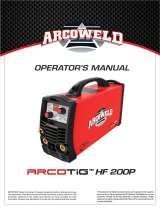
2 TIG WELDING
0460 447 174
- 12 -
© ESAB AB 2018
HotWireTIG
This function uses the power source to pre-heat a wire fed to an existing TIGmelt. This
results in a higher rate of production and also a better welding result than what is the case if
a cold wire is fed to the melt.
Having turned on the HotWireTIG function using the "h" parameter, the functionality is as
follows. If a triggersignal is generated or the "S" parameter (see below) is set to "1",
pre-heating will start and Hot Wire TIG will be indicated by a flashing TIG indicator.
If the voltage reaches a certain limit, an arc is considered to have formed and the power
source will try to put it out. This because the purpose of HotWireTIG is not to keep an arc
lit but to maintain a constant current aiming to heat the wire. You can set the voltage limit,
using the "U" parameter (see above).
In a system without a triggersignal, the "S" parameter can be used to automatically start
pre-heating.
WARNING!
When the "S" parameter is in position "1", there is a constant voltage on the
welding outlet. This is indicated by a flashing VRDindicator.
Micro pulse
In order to select micro pulse, the unit must be in pulsed current function. The
value for pulse time and background current is normally 0.02 - 2.50 seconds. By
using the micro pulse, the time can go down to 0.001 seconds. Whne the micro
pulse function is active, times that are shorter than 0.25 seconds are shown in
the display without decimal points.
Min current
Used to set the minimum current for the remote control.
If the max current is 100 A and the min current is to be 50 A, set the concealed function min
current to 50%.
If the max current is 100 A and the min current is to be 90 A, set the min current to 90%.
This function also applies when setting background current with pulsed TIG.























